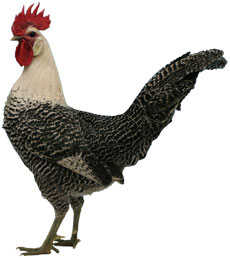
Uses: Exhibition, rare breed.
Eggs: 140 – 170 white.
Origin: Belgium.
Weight: Cock: 2.7Kg, Hen: 2.25Kg.
Bantam: Cock: 680g, Hen: 570g.
Colours: Silver, Gold (Standardised UK).
Useful to Know: Pronounced kam-peen, a rare breed that is seldom seen. The Campine also exists as a bantam in Europe but is not standardised in the UK in this size. Gold Campines are now very rare. The Campine is taken care of by the Rare Poultry Society.
Photo: Silver Campine, Large Male, owned by Goodwin & Mannion.
Campine chickens originated from Antwerp in the northern part of Belgium. Being so close to the border with The Netherlands and France, it’s no surprise that a number of ‘local’ breeds were thought to have contributed to its creation.
The Brakel, another breed from Belgium, the Hergines Fowl from France and the Chaamse Hoen from The Netherlands are all believed to have been involved in its creation.
The Campine was regarded simply as a village hen but the British enthusiasts of the time took them and refined them, creating an exhibition bird. They adopted hen feathered males to avoid the problems they had seen with double mating of Pencilled Hamburghs (double mating means keeping a pen to breed males and a separate pen to breed females).
A Campine Club was formed as early as 1900 but it wasn’t until 1903 that the first hen feathered Silver Campines started to appear after an import of eggs from Belgium that produced some hen feathered males. The subsequent hen feathered males that were hatched were passed around club members and crossed into Gold Campines to produce hen feathering in the Golds too.
The Bantam size didn’t appear in the UK until the 1950’s and has been sporadically seen since then. It’s thought that none currently exist in the UK. The Campine Club was merged into the Rare Poultry Society at its formation in 1969.
Breeding Hints
Campines need large grassy breeding pens with adequate shade (which also prevents silver birds plumage from discolouring). Due to the tail size of the male, sufficient space should be provided between the perch and the wall of the hen-house to prevent their tail feathers from breaking.
Photos
Books
The following books are available. Links take you to the Amazon or other sellers’ pages for the books.
- Rare Poultry Breeds – D. Scrivener – P.23
- British Poultry Standards – P.86
- American Standard of Perfection – P.244
Breed Clubs
These are the breed clubs for Campines:






